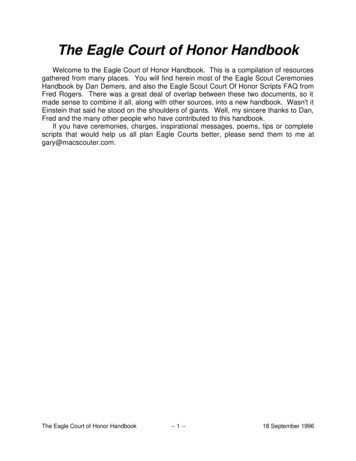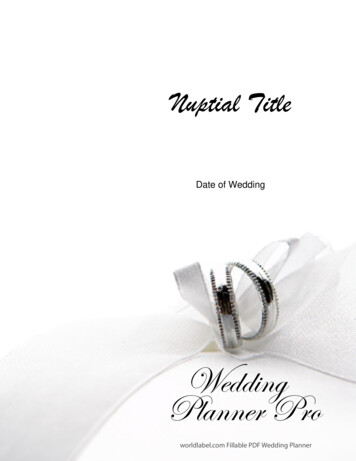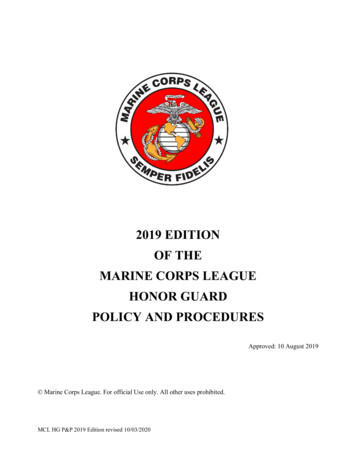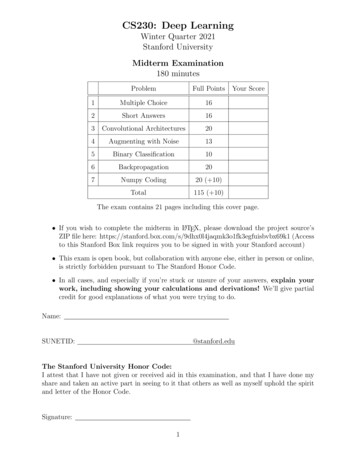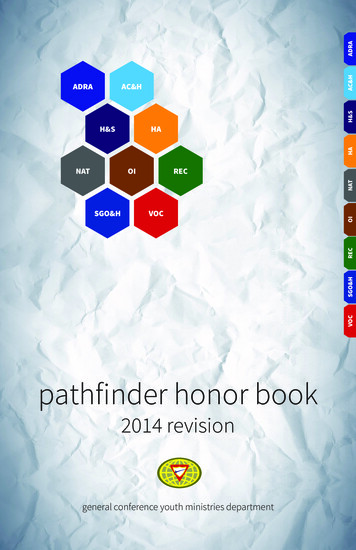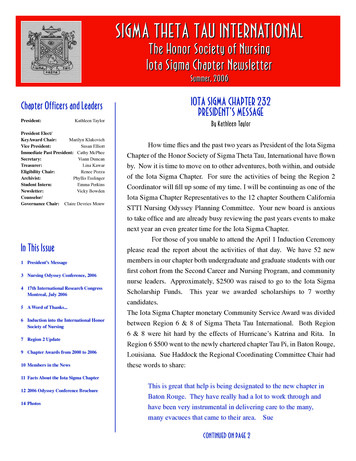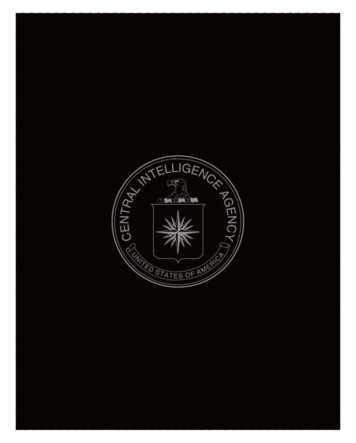
Transcription
IN HONOR OF THOSE MEMBERSOF THE CENTRAL INTELLIGENCE AGENCYWHO GAVE THEIR LIVES IN THE SERVICEOF THEIR COUNTRY* * * * * * * * * * * * * * * * * * * ** * * * * * * * * * * * * * * * * * * * ** * * * * * * * * * * * * * * * * * * ** * * * * * * * * * * * * * * * * * * * ** * * * * * * * * * * * * * * * * * * *
“We at CIA remember our heroes—the men and women commemoratedby stars on our Memorial Wall. Each of them, in their own way and owntime, strengthened America and helped spread freedom across the globe.”Director Leon E. PanettaJune 2009
IN HONOROFTHOSEMEMBERSOFTHECENTRAINTL ELIGEI NCEAGE CYWHOCAVETHEIRLIVESIN THESERVICEOF THEIR COU TRY***** ******* ** ** * * * ****Director and Mrs. Panetta at the June 2009 Memorial Service.
The men and women of the Central Intelligence Agency (CIA) workaround the clock and around the globe to make the United States moresecure. We put Country frst and Agency before self. We are dedicatedto the mission; we take the necessary risks to obtain the informationour country needs to protect itself in a dangerous world.It is important to refect on how few stars appear on the CIA MemorialWall, given the role the Agency plays as the nation’s forward line ofIN HONOR OF THOSE MF-MBE:RSOF THE CENTRAL INTfll IGENCE AG[NCYWHO GAVE THEIR LIVES IN THE: SERVICEOF THFIR COUNTRY* * * * * * * * * * * * * * * * * * * ** * * * * * * * * * * * * * * * * * * * ** * * * * * * * * * * * * * * * * * * ** * * * * * * * * * * * * * * * * * * * ** * * * * * * * * * * * * * * * * * * *defense. We accomplish what others cannot accomplish and go whereothers cannot go. Our offcers are frequently frst on the ground in areasof unrest, often without the beneft of additional support, always inharm’s way.The men and women of CIA do their work with no expectation ofrecognition, knowing that if they make the ultimate sacrifce, the detailsof their efforts are likely to be known to just a very few.We honor those Agency offcers who have come before us.The Memorial Wall today. The artist’s concept emphasizes the unity of the stars on the Wall.They stand as a feld. No individual star belongs to a particular honoree.4Ir1
I HO IOF T iE CEV\1110 GA E THEIR LI**** *RememberingThe men and women of CIA are united by a mission essential to ourcountry. They act as a team, often living overseas and working longhours to help our nation meet diffcult security challenges. When* * ** * * *an offcer dies in the line of duty, it is only ftting that there be aplace to remember and pay tribute to that colleague, and friend.For the people of CIA, that is the Memorial Wall. It is dedicatedto those we have lost and it is a lasting reminder of their heroism,the risks inherent in the intelligence profession, and our pledgeto put service before self. The Wall—and the stories of the people itcommemorates—inspire all who carry the mission forward. It affrmsour own commitment to the American people.“These stars are testament to our past andour present. To our history and our spirit.To a defning trait of the CIA and the nationit protects: devotion to duty in pursuit offreedom for all.”Director George J. TenetMay 20047
Who gets a Star?WHOG*** *** * ** * · *'ii.- .;-*p./ - :'The stars carved in marble in CIA’s HeadquartersNot every fallen employee receives a star. The CIA’sLobby are a simple, silent memorial to employeesHonor and Merit Awards Board will recommend thatwho have died in the line of duty. The inscriptionthe CIA Director approve a star if the nominationabove the stars reads, “In honor of those membersmeets specifc and current criteria:of the Central Intelligence Agency who gave theirlives in the service of their country.”*Director Michael V. HaydenMay 2008aspect of the Agency’s mission, from covert actionand collection to analysis, support and technicalcapabilities. They came from every Directorate,character while in the performance of duty; or as the result of an act of terrorism while in theperformance of duty; or as an act of premeditated violence targetedeither as staff offcers or contractors. They servedagainst an employee, motivated solely by thatin every corner of the world, many of them inemployee’s Agency affliation; orwar zones and other places of great danger. They in the performance of duty while servingworked against every national security challengein areas of hostilities or other exceptionallyfaced by the United States since CIA’s founding inhazardous conditions where the death is a direct1947. The men and women came from a varietyDirector Hayden saluting feld of stars.United States. Death must be of an inspirational or heroicThose remembered with stars performed every“The Americans commemorated by these stars camefrom all walks of life. They heard the call to duty andchose to serve in an agency unlike any other. Quietpatriotism was their hallmark. They would advancefreedom and build a better world, not for public acclaim,but because it is the right thing to do.” Death may occur in the foreign feld or in theresult of such hostilities or hazards.of backgrounds refecting America’s rich diversity.Once the Director endorses a nomination, the OffceWhile many had years of service, others were young;of Protocol arranges placement of the star on thethe youngest was 21 at the time of her death.Memorial Wall.9
History of the WallIn February 1973, Agency offcers proposed that a memorial plaque be placed at CIA Headquarters tohonor employees who had died in Southeast Asia, primarily in Laos and Vietnam. The Honor and MeritBoard expanded the concept to recognize all CIA offcers who had fallen in the line of duty. AgencyIN HONOR OF THOSE MEMBERSOF THE CENTRAL INTELLIGENCE AGENCYWHO GAVE THEIR UVES IN THE SERVICEor THFIR COUNTRYoffcer Edward Ryan, then Chairman of the CIA’s Fine Arts Commission, met with a representative from* * * * * * * * * * * * * ** * * * * * * * * * * * *the American Foreign Service Association to discuss the criteria used for the Memorial Plaques in the* * * * * *lobby of the US Department of State. Later, the US Commission of Fine Arts recommended Master StoneCarver Harold Vogel to design the CIA Memorial. Vogel had extensive experience—including havingcarved the lettering on the marble walls at The John F. Kennedy Center for the Performing Arts.c::Vogel’s design inspiration for the Memorial Wall came from the Bauhaus style—a modernist conceptEarly photo of the Memorial Wall showing 33 stars.also known as the International Style—which is marked by the absence of ornamentation and by harmonybetween the function of an object and its design. Vogel’s goal was to make the memory of the fallenan integral part of the building which, to many, represents the Agency’s mission. His vision of the CIA’sMemorial emphasized the unity of the stars on the wall, standing as a feld.His concept was approved in November 1973 and the original 31 stars were approved by DirectorWilliam E. Colby in April 1974. Three months later, Vogel carved the Memorial. It was done withoutfanfare. No ceremony was held; no pictures were taken—the stars and inscription simply appeared.10“The stars on the Memorial Wall are to us more than symbols,more than history. They are a priceless part of who we are.They are the colleagues and leaders who defne us—indedication and in sacrifce. It is in this new century theirmission we seek to accomplish. And it is their commitmentof which we seek to be worthy.”Deputy Director John E. McLaughlinJune 200111
Tl-io E \ IE.\IBERI TEUICE CE -\GE C\HE ERViCEOF THEIRcou TR\***** *“When we move on—whether to anotherchapter in our careers or our lives—wenever lose the distinct sense of pride inbelonging to such a storied and exceptionalorganization. Nor do we ever forget havingbeen in the company of such remarkablytalented men and women, especially thosewe honor today, whose deeds are immortal.We see, in our mind’s eye, these deep-cutstars engraved in marble, and we knowthat we always will be part of somethingnoble and worthy.”Director Porter J. GossMay 200612* * * ********************
The Stone Carvers—Their storyMaster Stone Carver Harold Vogel was born in Detroit, Michiganto an immigrant family from Ansbach, Germany. After the stockmarket crashed in 1929, the family returned to their home townin Bavaria and the family business—stone quarries and carving.During his formative years, he spent a great deal of time with hisgrandfather, a restoration sculptor, who taught Vogel how to use ahammer and chisel. In 1945, he began a stone carving apprenticeshipin Nuremberg, and, after receiving his master craftsman certifcate,came back to the United States and volunteered to serve in the USArmy. Vogel eventually settled in Washington, DC and studied at theCorcoran School of Art (now The Corcoran College of Art Design)and George Washington University. Vogel worked on the NationalCathedral, the US Capitol building, and completed all the letteringon the marble walls of The John F. Kennedy Center for thePerforming Arts.14Designer of the Memorial Wall—Harold Vogel.
Stone Carver Tim Johnston learned his craft as an apprentice toVogel. Johnston watched Vogel carve stars on the Memorial Wallfor several years before he was allowed to carve a star with hisown hand in 1989.Johnston was born in Denver, Colorado. His father worked for theDepartment of Agriculture and moved to Northern Virginia in 1966when Johnston was a young boy. At the age of 12, Johnston beganworking during the summers in the marble and tile industry. Aftergraduating from high school, he worked full time for a tile company,but his interests shifted to stone setting, and fnally, stone carving.The Memorial Wall is a bittersweet project for Johnston. He is proudto help recognize CIA’s mission and the sacrifces made by Agencyoffcers on behalf of the nation. Yet each time he must come to CIA,he does so with a heavy heart aware that an offcer has fallen.“When Harold Vogel designed the originalwall, it was not intended for the large numberof stars that appear today. It is a very sadthought, all those sacrifces.”Tim JohnstonStone CarverStone Carver Tim Johnston.17
Johnston uses Vogel’s original 1974 template—which, when not inuse, is locked in a safe—to ensure that every star is the same. Eachone is frst drawn by hand; the carving itself takes about one hour.Each star measures 2¼ inches tall by 2¼ inches wide and half an inchdeep; the stars are six inchesapart from each other, as arethe rows. Johnston uses botha pneumatic air hammer anda chisel to carve out the tracedpattern. After he fnishescarving the star, he cleans thedust and sprays the star darkgray, which with age, acquiresTools used by both stone carvers.its own patina.Johnston approaches his task with exceptional care. He describes theexperience in his own words: “I only have one shot to carve the star—marble is unpredictable, you can never be sure how it will act—it’s ascary situation. But at the same time it’s a fantastic thing to do.”Stone Carver Tim Johnston at work: “Once I begin my work the rest of the world is blacked out.”19
The Book of HonorThe Book of Honor—on display in front of the Memorial Wall atall times—contains the names of employees who died while servingtheir country. Each is next to a 23-carat gold leaf star. For reasons ofsecurity—to protect intelligence sources and methods—the namesof some of those on the Wall must remain secret, even in death.Each of these offcers is remembered in the book by a gold star alone.“The stars are what made this country great and their namesshould be in a Memorial book, not as signage on the wall.”Harold VogelMaster Stone CarverOriginal Book of Honor used from 1974-2004.2021
. ,c,,.,.r. ,.·,;.1.,.'9G111.,.,.,.,,.A.S., l,.-.,.hJ;:,.t,.,:t C . 5,.,.,t,t ,-W.U,."·" . . .,w.11;.,. , P. l\;,1-. 1.n Part of Vogel’s concept for the Memorial Wall included a displaycase to house the Book of Honor. The cover of the book, never seenby the public, displays a 22-carat gold embossed Agency seal.h,,-.,1 . .Qw c .J,·.11.ul C. 0,-.vi [\,1vi.-t l . F; Bn.k . , · :. . - -R .111.-n· ;,.,.,.,j.,lnmvl11id,c- 1l J'm H'914! TSWillim.,E. Bc1111eflJ.:id,nwt S. w .ld, t;k: .'c,! .;:::: :.Vogel selected Levant leather—from Morocco—with a soft pebblegrain texture commonly found in fne book binding. The insidecover is light tan silk end sheets. The original book is small in size,25 inches x 9 inches. Sadly, by 2004, the 83rd star had beenadded to the original book and it was poignantly apparent thata larger book and case were required. Vogel and his apprentice,Original Book of Honor used from 1974-2004.Johnston, designed and built the current case out of Carrara marble(measuring 36 inches x 22 ½ inches), leaving a resting place forthe original book to lie underneath.*22f. Bu-,k leyR;d . n,-t 0. K,,.,.(.,kJ.:a. ,.w.s1 . ,1:,,.,.'J. J ··11. 1.t.e. . .,.J.,.J,.,q.' ""1!)84H.,.,,.,.,1c.,,.,y* * * **Current place of rest for the Book of Honor.t,. e,.,.r. H . \Vil\i . ,,R-.,.-,;.c.,.i.,,,('l.l'1.1 ,.i,. .c-,1.,.1\111,.tl.,.:
The second book is almost double the size of the original, but in allother ways an exact duplicate. The outside of the book is 20 inchesx 32 inches and the page size is 18 inches x 29 ¾ inches. The Archespaper—selected for its high archival quality and calligraphy receptivesurface—has rough, deckled edges typical of handmade paper.LEFT: Outside cover of the Book of Honor with embossed Agency seal.NEXT PAGE: The Book of Honor from above.25
The book is a work of art thanks to the skill of a professional calligrapher—a CIAemployee—who writes each name and draws each star. She uses a dip pen, not afountain pen; black sumi ink is used for its ease and glossy fnish; a Mitchell roundhand square nib, size three and a half, is reserved exclusively for the book; the goldstars are hand drawn with a Gillott number 303 nib; the shell gold is made in Francefrom a hundred-year-old recipe. The stars are polished using an agate burnisher.The style of lettering was selected by the calligrapher for its functionality andreadability. “The importance is in the names, not the lettering,” she said.When a star is added to the Wall, the Book of Honor is updated concurrently.26Professional calligrapher at work.
Calligraphy tools used for the Book of Honor.2829
IN HONOR or THOSE,\1EMBERSOF THE CENTRALINTELIIGENCEAGENCYWHO GAVE THEIRLIVESIN THESERVICEOF THEIRCOUNTRY*************************Memorial CeremonyThe frst annual Memorial Ceremony was held in 1987, 13 years afterthe Memorial Wall was created. The suggestion to hold a yearlycommemoration came from an Agency offcer. The idea came to himafter he showed his son the Memorial Wall.At the time of the frst ceremony, the Agency was in its 40th year andthere were 50 stars on the wall. Deputy Director Robert M. Gatespresided. It was a simple event, attended by a small number of Agencyoffcers. The offcer who made the suggestion to hold a ceremony said,“ having been born abroad, in a communist country at that, my smallcontribution to this memorial meeting makes me especially proudof being an offcer of this great Agency.”“Ceremonies that honor the dead are, in truth, for the living.They remind us of our mortality but also celebrate thelives and memories of those we have loved, trusted andrespected. Certainly, we mourn their loss—but we alsoglory in the knowledge of their extraordinary contributionto our service and to our country.”Deputy Director Robert M. GatesMay 198730* * * * * * * * * * ** * * * * * * * *.
WHOGA f* E RCCi Jf HESERVICEOF* * * * * * * * * * * ** * * * * * * * * * * * ** * * * * * * * * * * **Each year since then, the Agency has gathered to remember its fallen ina solemn setting closed to the public. Though the themes of the serviceand sacrifce are constant, the event has changed over the years: In 1990, under Director William H. Webster, non-Agency familymembers were invited to the ceremony, which until then had beenfor employees only. In 1995, Director John M. Deutch, had the names of all offcersremembered on the Wall, including those still undercover, read aloud,a practice that continues to this day.Deputy Director Gates placing wreath before the Wall during the 1987 Memorial Ceremony. In 2009, Director Leon E. Panetta presented the family of eachfallen offcer with a replica of a memorial star. Each keepsake staris carved by Tim Johnston out of the same type of marble usedin the Memorial Wall.IN HON OR or THOSE M LMBLRSOF THE CENTRAL INT[LI IGENCE AG[NCYWHO GAVE THEIR LIVESIN TI fl SERVICEOF THflR COUNTRY* * * * * * * * * * * * * ** * * * * * * * * * * * ** * * * * * * * * * * ** * * * * * * * * * *Keepsake star presented to the families.The Memorial Wall with 50 stars.33
The Memorial Ceremony is one of the largest annual events at CIA. It is open onlyto Agency employees and the family members of our fallen offcers.The ceremony is held in the Headquarters lobby in the late morning. It beginswith the audience standing for the presentation of colors by the CIA Honor Guard,the National Anthem, and an invocation or opening prayer.The Director of the CIA typically presides over the event and delivers remarks. Thosecomments highlight the sacrifces made by Agency offcers in defense of this nationand often profle specifc individuals honored with a memorial star. The names of thefallen are then read by four senior Agency offcers, representing each Directorate.Following the roll call, a wreath is placed before the Wall. The ceremony concludeswith a benediction and the playing of “Taps.”Preparing for the Memorial Ceremony.3435
TimelineIn May 1996, the Memorial Ceremonywas held outside to mark the formalopening of the Memorial Gardenlocated on the Headquarters compound.Through the quiet beauty of livingnature, the garden is a tribute to alldeceased intelligence offcers andcontractors who served their country.The garden was professionally designedand features a small pool, waterfall, andlighting. A plaque nearby reads: Inremembrance of those whose unheraldedefforts served a grateful nation.1973The design for the Memorial Wall is approved—a memorial dedicated to Agency employees who losttheir lives in the line of duty.1974Master Stone Carver Harold Vogel carves 31 stars intomarble at CIA Headquarters.1987First annual Memorial Ceremony is held.1990First time non-Agency family members of the fallenThe Color Guard at the Memorial Garden.are invited to attend the Ceremony.1995First time all the names on the Wall are read aloudregardless of cover status.2009The family of each fallen officer receives a replicaof a memorial star.37
A publication of the Central Intelligence AgencyOffce of Public Affairswww.cia.govJune 2010
Original Book of Honor used from 1974-2004. The Book of Honor . The Book of Honor—on display in front of the Memorial Wall at all times—contains the names of employees who died while serving their country. Each is next to a 23-carat gold leaf star. For reasons of secur
